Radish Greens Pesto Pasta
Radish Greens Pasta, an easy pesto pasta recipe using radish leaves instead of basil. A sustainable twist on classic pesto pasta!
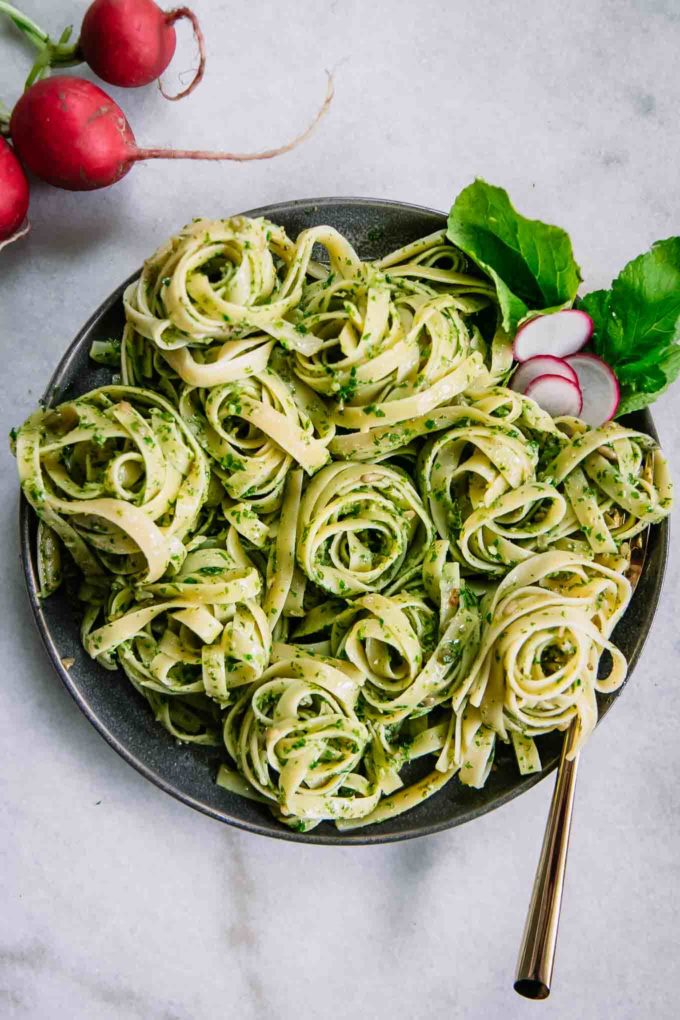
Want to Save This Recipe?
Enter your email & I’ll send it to your inbox. Plus, get new plant-based recipes in your inbox!
By submitting this form, you consent to receive emails from Fork in the Road.
Not sure what to do with those radish tops? Make a radish greens pesto pasta! Our Radish Greens Pesto recipe is a unique food waste prevention twist on classic pesto, so we decided to show the sauce in action in this easy pesto pasta recipe.
Not convinced that radishes belong in pesto…or on pasta? Here are a few reasons why you should be making pasta with radish pesto:
- It’s delicious! First and foremost, pasta with radish leaves pesto is super tasty. With a rich, earthy flavor this will become your new favorite easy weeknight meal that’s perfect for leftovers.
- Pesto sauce is super versatile. Use any extra pesto in soups, stews, and on top of roasted or grilled vegetables. The pesto possibilities never end!
- It reduces food waste. This recipe helps you become a more eco-friendly home cook by using up radish greens that would otherwise be thrown out.
Ready to learn how to make this so-easy pasta with radish leaf pesto? Let’s do it!
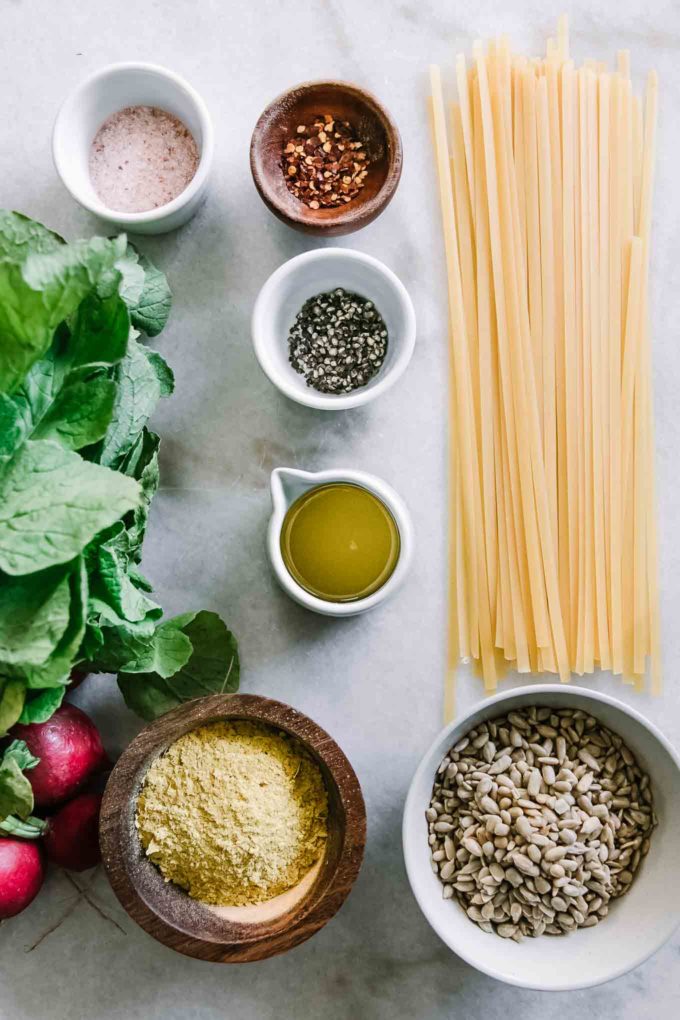
👩🍳 How to make pasta with radish greens (step-by-step)
1️⃣ Step One: Wash, dry, and cut radish greens
First, cut the radish tops from the stems close to the leaves. Use the radish roots in salads, soups, or even baked into crispy veggie chips.
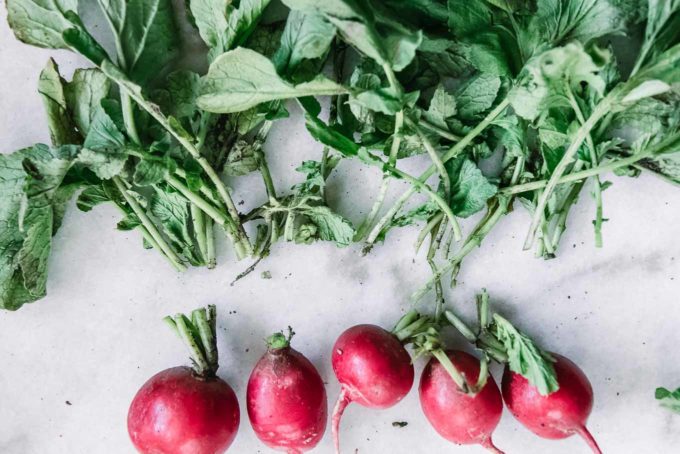
Place the greens in a bowl of water and use your hands to remove excess dirt.
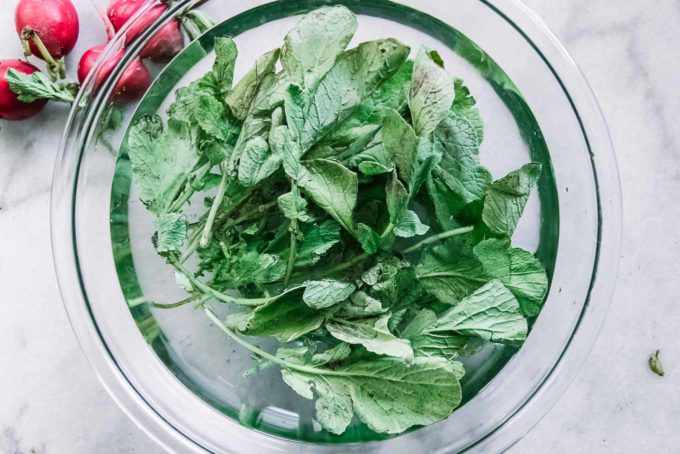
When greens are clean, remove from water and either spin in a salad spinner or place in a colander to let dry (about 5 minutes). Once the leaves are dry pick out any remaining hard stems.
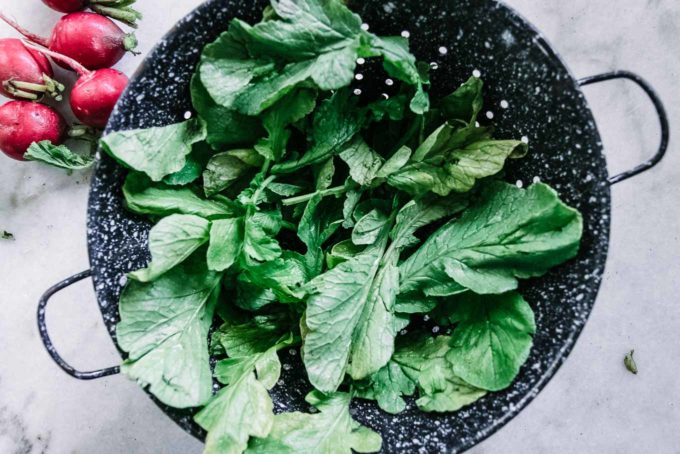
👉 Food Waste Tip: See our full step-by-step tutorial on preparing radish greens. And learn how to properly refrigerator, freeze, and even pickled radishes to keep them fresh longer.
2️⃣ Step Two: Prepare radish pesto
Add radish greens, pine nuts (or other nuts/seeds of choice), garlic cloves, olive oil, cheese (or nutritional yeast, if vegan), and a generous pinch of salt and pepper to a food processor or blender.
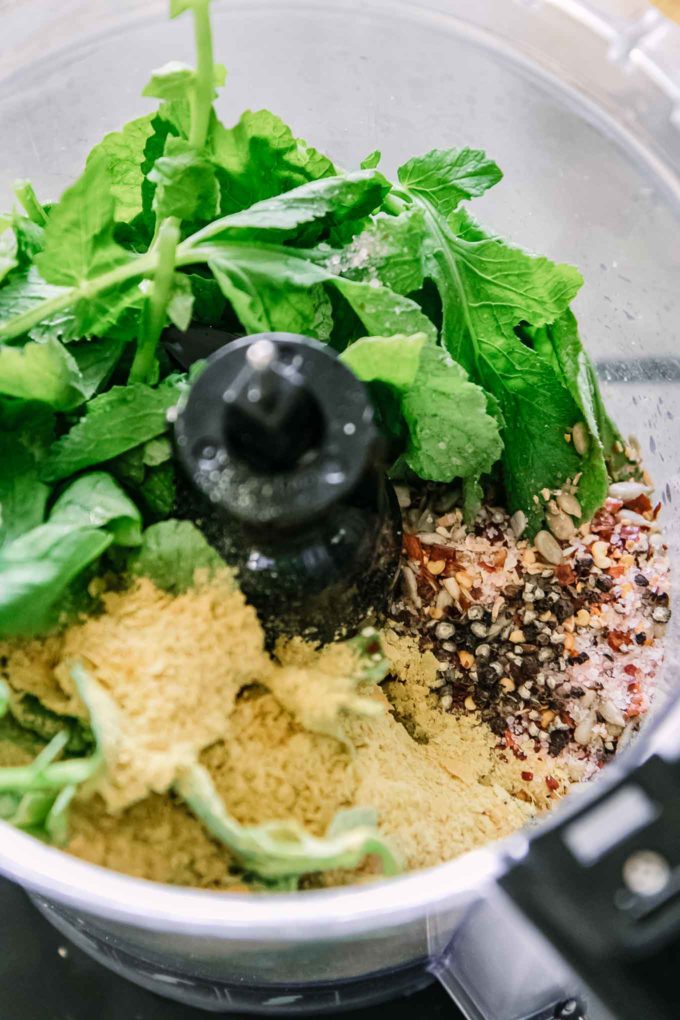
Pulse the ingredients, adding more oil if needed, but keeping pesto a thicker consistency (we don’t want runny pesto, we want thicker pesto that coats the pasta noodles).
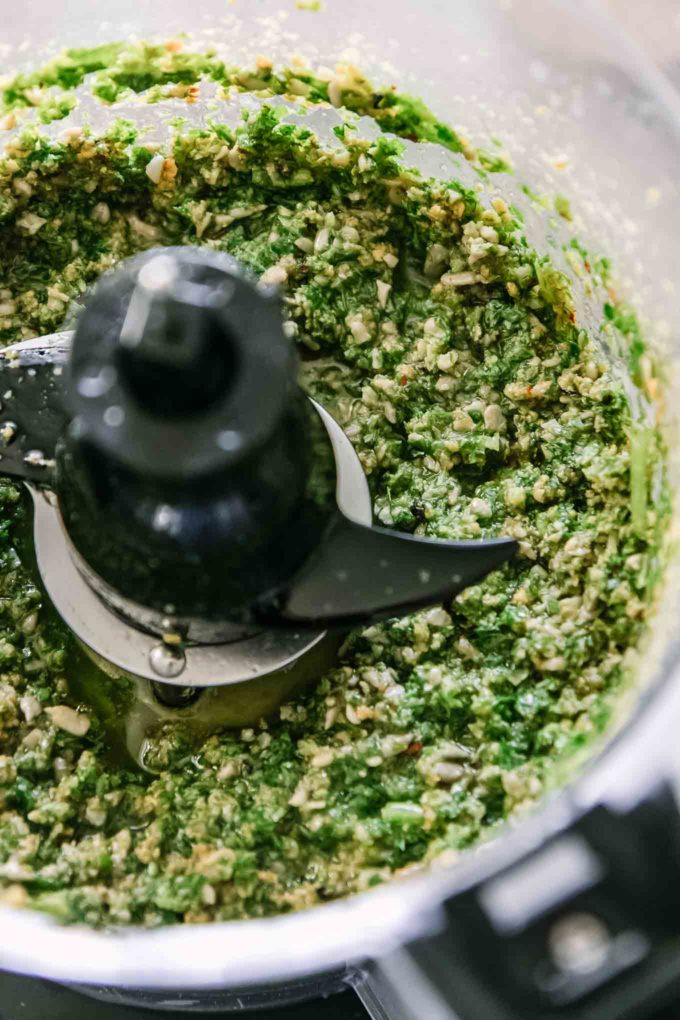
👉 How can I make pesto nut-free? If you want to make a nut-free pesto, we suggest sunflower seeds or pumpkin seeds. You can also use beans or even chickpeas, like in our Nut-Free Chickpea Pesto.
3️⃣ Step Three: Boil the pasta
Bring a large pot of water and a generous pinch of salt to a boil, then add pasta and cook to al dente (about 8-10 minutes). Drain water, reserving ½ cup of pasta water.
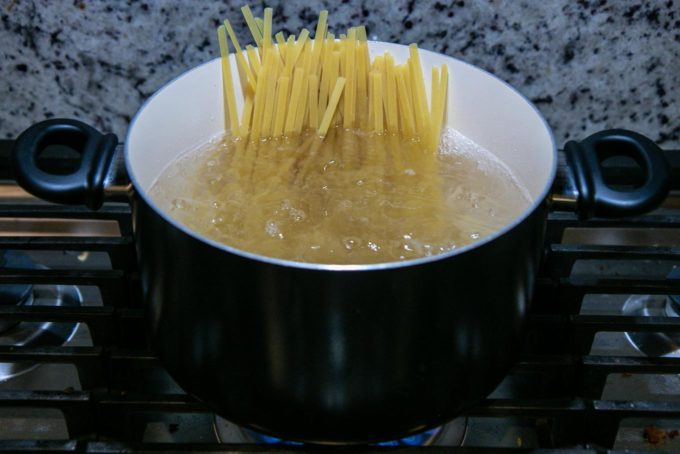
👉 What type of pasta should I use in pesto pasta? Because pesto is a thick sauce, most any type of pasta will be delicious. However, we like either a thick long noodle like bucatini or a curly short noodle like rotini. We chose fettuccine in this recipe, but you can truly use any type of noodle with pesto sauce.
4️⃣ Step Four: Prepare pesto pasta
Add pesto to a large pan and heat over low, adding a small amount of the reserved pasta water and letting it cook down for about 1-2 minutes (the starch in the water will help thicken the sauce).
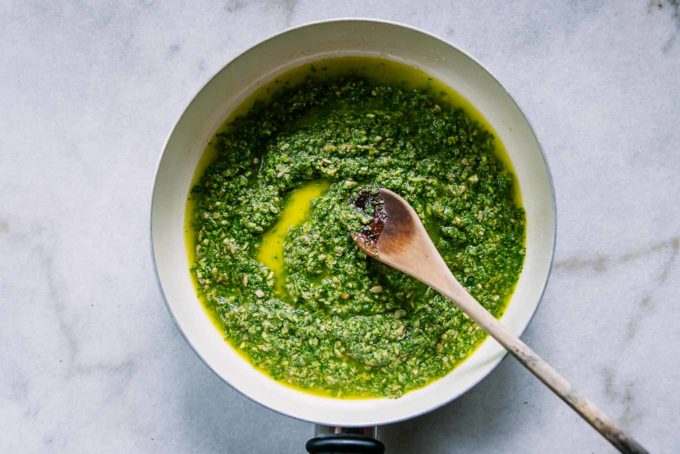
Add the cooked pasta and toss to coat the noodles completely in the pesto sauce. Give the pasta a taste and add any more spices or salt and pepper, if needed.
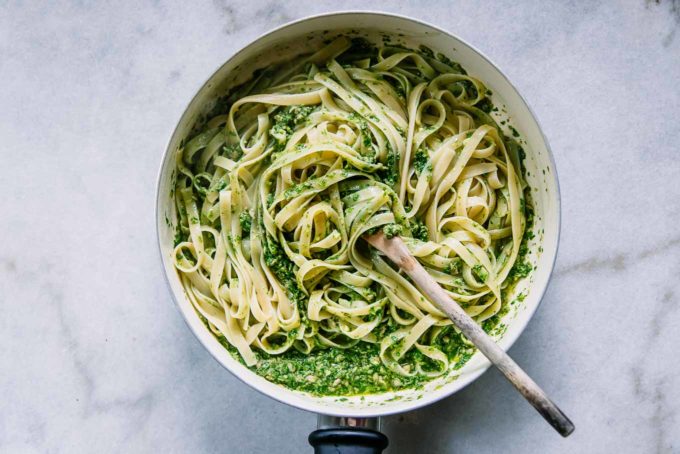
To serve, plate the pasta and sprinkle with a bit of parmesan cheese, or if you’re vegan then a small amount of vegan parmesan or nutritional yeast. We also like to add more vegetables by including sliced cherry tomatoes and carrots, and a sprig of radish greens for garnish.

❓ Recipe + ingredient questions
Radish tops can be used in place of any herb like parsley or cilantro in most recipes. They are delicious in sauces like pesto and chimichurri, salads, pastas, in broths and soups, and even on their own as a side dish.
You can eat radish tops raw, they do not need to be cooked before eating. In fact, they’re delicious in salads, sauces, and dips. However, make sure to wash radish greens thoroughly because they are a root vegetable so they typically have dirty leaves since radish roots are grown in the soil.
In addition to making radish top pesto pasta, you can also toss pasta in an oil-based sauce with garlic, carrots, tomatoes, and carrot leaves. The pasta possibilities are endless for radish greens.
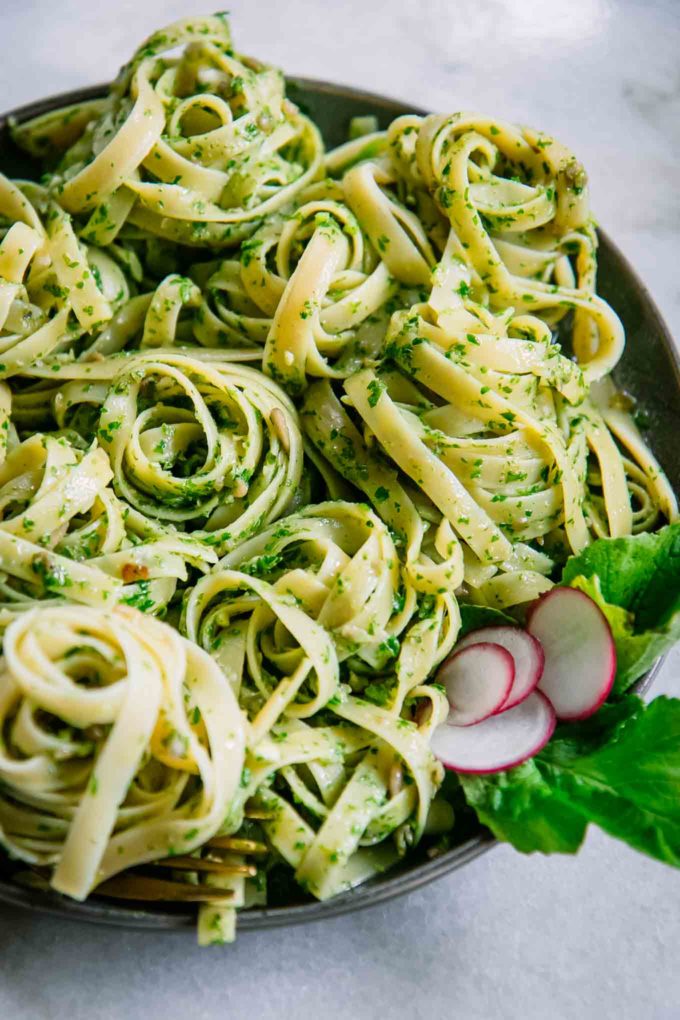
♻️ Sustainable kitchen tips
We believe that living a green lifestyle starts in the kitchen, so here are a few tips to make this recipe healthy for you AND the planet.
Use root-to-stem cooking techniques. The great thing about radishes is you can truly use root-to-stem cooking on all parts of the vegetable. Use radish roots in salads or bake sliced radishes into chips, use the stems to season a homemade vegetable broth, and use the tops in a sauce like chimichurri.
To make this recipe healthier, choose whole grain pasta. Choose whole grains whenever possible, including in pasta. Whole grain pasta is higher in fiber and other nutrients compared to refined white pasta and is closer to grain’s natural state, which means it’s a healthier choice for you and for the planet (EAT Lancet Report).
Stock up on pesto for other meals. Did you make more pesto than you actually need for this pasta? Great! Freeze it in an airtight container for up to 2-3 months to enjoy later in soups, stews, and on top of roasted or grilled vegetables.
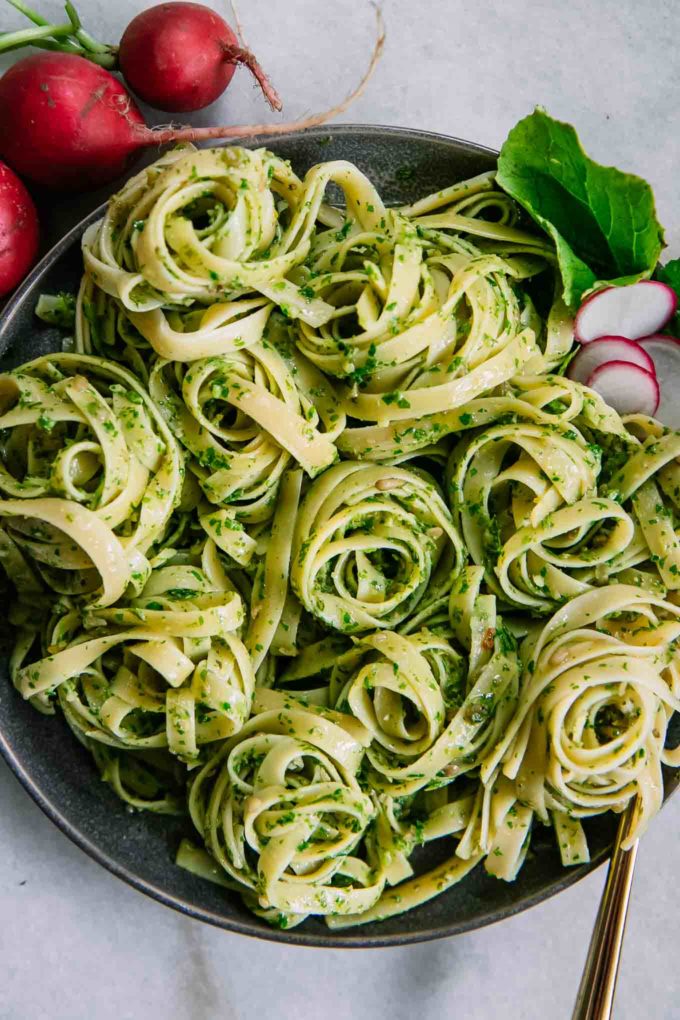
🌱 More recipes using radish leaves
We love reducing food waste by using up radish tops in interesting ways. Here are a few of our favorite recipes:
- Want to make a big batch of this pesto? Check out our recipe for Radish Greens Pesto
- Toss tops with spices and oil into a Radish Top Chimichurri
- Sauté up radish tops on their own in this Sautéed Radish Greens
- Make crispy oven-baked chips with radish leaves
- Blend radish greens into a superfood smoothie
- Make vegetable soup with radish leaves and radish roots
Interested in more pesto pasta recipes? Try our Carrot Top Pesto Pasta and Pesto Pasta with Beet Leaves.
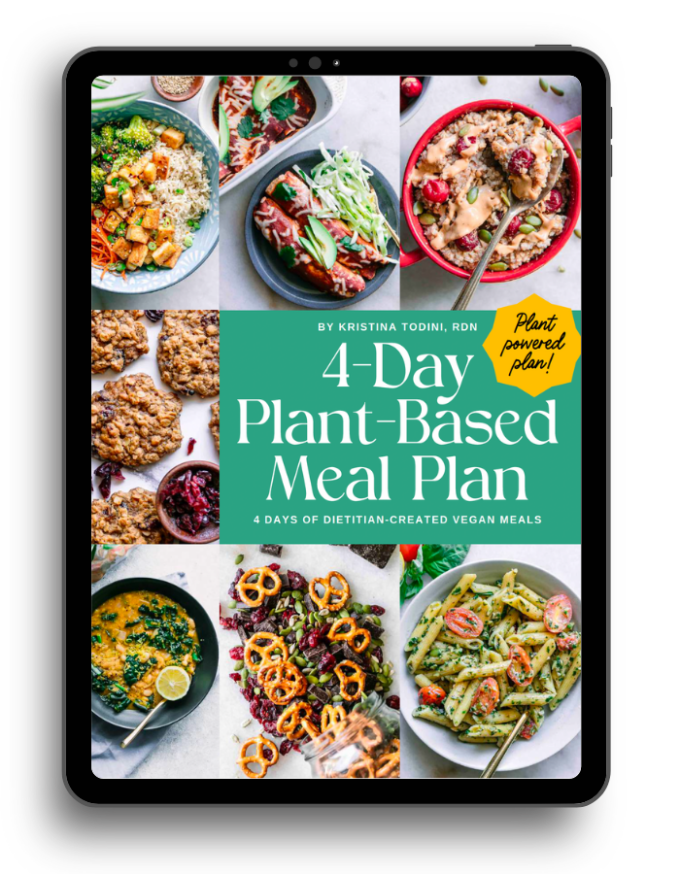
NOT SURE WHERE TO START WITH PLANT-BASED EATING?
Get my 4-Day Plant-Based Meal Plan to start your journey on the plant path.
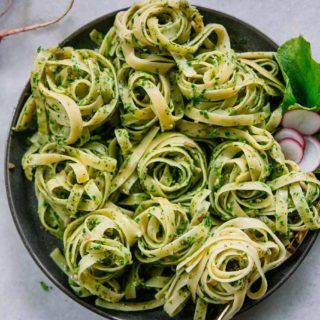
Radish Greens Pasta Recipe
Ingredients
- 6 ounces pasta (rotini, fettuccine, etc.)
- 1 tablespoon salt for pasta water
- 2 cups radish tops and stems from about 8 medium carrots
- ⅓ cup pine nuts or seeds if nut-free
- 2 whole garlic cloves
- ½ cup extra virgin olive oil
- ½ cup vegan parmesan cheese or nutritional yeast
- ⅛ teaspoon sea salt
- ⅛ teaspoon black pepper
- Optional: sliced carrots, cherry tomatoes, carrot greens for garnish
Instructions
- Wash, dry, and cut radish tops: Cut radish root from the stem*. Cut the radish greens from the stem and place in a colander or bowl to wash, rinse well to remove dirt, then set aside to dry (about 20 minutes). Once dry, remove any remaining hard stems from leaves.
- Prepare radish top pesto: In a food processor or blender, add radish greens, pine nuts or seeds, garlic cloves, olive oil, cheese or nutritional yeast, sea salt, and black pepper. Pulse to combine, adding more oil if needed, but keep pesto a thicker consistency.
- Boil pasta: Bring a large pot of water and a generous pinch of salt to a boil. Add desired pasta (we used fettuccine in recipe photos) and cook to al dente (or semi-firm) according to package instructions. Typically this means 8-10 minutes, depending on the pasta shape you choose (thicker pasta shapes require more time). When pasta is done, reserve ½ cup of pasta water and then drain pasta and set aside.
- Prepare pesto pasta: In a large pan over medium-low heat, add pesto to pan with a small amount of reserved pasta water and heat for 1 minute. Add cooked pasta and toss to coat it in pesto. Remove from heat, plate, and serve.
Notes
- Nut-free, vegan, and gluten-free variations: If you cannot eat nuts and are looking to make a nut-free pesto, we suggest using seeds like sunflower seeds or pumpkin seeds. You can also use beans or even chickpeas. If you are vegan, use either vegan parmesan or nutritional yeast in place of cheese. Use gluten-free pasta, if needed.
- Tools needed: large soup pot, food processor, cutting board, knife set
- Prep ahead: Prepare the radish top pesto up to four days ahead of time.
- Leftovers and storage: Store leftovers in an airtight container in the refrigerator for up to 4 days; we do not recommend freezing cooked pasta, but you can freeze the pesto and thaw before cooking pasta.
- Nutrition notes: This recipe is a plant-based pesto pasta recipe, using radish tops instead of basil. We suggest whole grain pasta when necessary to increase fiber and nutrient content.
